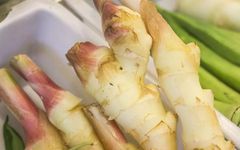
Fresh ginger (Sheng Jiang) and dried ginger (Gan Jiang) both originate from the rhizome of the ginger plant (Zingiber officinale). Processed ginger (Pao Jiang) and ginger charcoal (Jiang Tan) are products derived from dried ginger. Although they share the same root, fresh ginger and dried ginger are different cultivated varieties of the same plant.

Fresh Ginger (Sheng Jiang)
During the cultivation of fresh ginger, soil is continuously piled around the rhizome, forcing the plant to grow upwards due to its phototropism. The longer it grows, the more it stretches. The “young ginger” (Zi Jiang) we see in markets during summer and autumn is what was referred to as fresh ginger in ancient times; it is tender, has few fibers, and is very crisp. In contrast, dried ginger does not have soil piled around it, allowing the rhizome to be exposed to light. As a result, it does not grow vigorously, leading to a higher accumulation of internal components. After drying, it does not shrink significantly and has a heavy texture. According to the “Compendium of Materia Medica” (Ben Cao Gang Mu), fresh ginger, dried ginger, and processed ginger are three distinct medicinal substances. We cannot simply consider dried ginger as the dried form of fresh ginger.
In contrast, dried ginger does not have soil piled around it, allowing the rhizome to be exposed to light. As a result, it does not grow vigorously, leading to a higher accumulation of internal components. After drying, it does not shrink significantly and has a heavy texture. According to the “Compendium of Materia Medica” (Ben Cao Gang Mu), fresh ginger, dried ginger, and processed ginger are three distinct medicinal substances. We cannot simply consider dried ginger as the dried form of fresh ginger.
Modern research has found that the chemical compositions of fresh ginger and dried ginger are not entirely the same. The use of fresh ginger and dried ginger as two different medicinal substances is not merely due to the difference in moisture content, but rather due to significant differences in their chemical components, which also leads to distinct therapeutic effects.
Fresh ginger has a pungent taste and a slightly warm nature. It enters the lung (Fei), spleen (Pi), and stomach (Wei) meridians. It has effects such as inducing sweating and releasing the exterior, warming the middle and stopping vomiting, warming the lungs and stopping cough, and detoxifying. When it enters the lung meridian, it can warm the lungs, dispel cold, promote lung qi, and alleviate phlegm and cough, commonly used for wind-cold cough and cold-phlegm cough. When it enters the spleen and stomach meridians, it can warm the stomach, dispel dampness, transform phlegm, and relieve nausea, earning it the title of “sacred medicine for vomiting.” Regardless of the cause of vomiting, whether from wind-cold, dampness stagnating in the middle, or cold in the stomach, it is effective. In formulas like Wu Zhu Yu Tang and Xiao Ban Xia Tang, fresh ginger is primarily used to warm the middle and stop vomiting. In Xiao Chai Hu Tang, Da Chai Hu Tang, and Chai Hu Gui Zhi Tang, fresh ginger is used to strengthen the stomach and stop vomiting, guiding pathogens out. In Ban Xia Hou Po Tang, fresh ginger is used to warm the middle, transform phlegm, and stop vomiting.
In the hot summer or due to certain diseases, the secretion of saliva and gastric juice may decrease, affecting appetite. Eating a few slices of fresh ginger before meals can stimulate the secretion of saliva, gastric juice, and digestive fluids, increase gastrointestinal motility, and enhance appetite. This is the reasoning behind the saying, “Eat radishes in winter and ginger in summer,” and “If the food is unappetizing, eat fresh ginger.”
Fresh ginger can detoxify Ban Xia (Pinellia ternata), Tian Nan Xing (Arisaema), and the toxins from fish and crabs. Therefore, Ban Xia and Nan Xing are often prepared with ginger.

Dried Ginger (Gan Jiang)
Dried ginger has a pungent and warm taste and enters the heart (Xin), lung (Fei), spleen (Pi), stomach (Wei), and kidney (Shen) meridians. It has functions of warming the middle, returning yang, and transforming phlegm. It is effective in warming the yang of the spleen and stomach to eliminate internal cold, making it a key medicine for warming the middle jiao. It can be used for symptoms of internal cold, yang deficiency, or cold in the spleen and stomach, such as vomiting, diarrhea, and abdominal pain.
Due to its ability to warm the spleen and transform cold phlegm, it can also treat cough and wheezing caused by cold phlegm invading the lungs, with symptoms of clear, thin phlegm and cold body. The “Compendium of Materia Medica” (Ben Cao Qiu Zhen) summarizes it as: “Dried ginger is very hot and non-toxic, it stays in the body and does not disperse. For cold in the stomach, if the original yang is about to collapse, it can be combined with Fu Zi (Aconite) to restore yang effectively, hence the saying that ‘there is no heat without ginger in the formula with Fu Zi.'” It is often used with Fu Zi to treat heart failure with weak pulse and critical conditions. It is also commonly combined with Huang Qin (Scutellaria baicalensis), Huang Lian (Coptis chinensis), and Ce Bai Ye (Platycladus orientalis) to treat syndromes of combined upper heat and lower cold, such as Yangming and Taiyin diseases, and Jueyin diseases. For Taiyin disease, it is used in Si Ni Tang, and for Jueyin disease, it is used in Ban Xia Xie Xin Tang and Wu Mei Tang.
Fresh ginger focuses on warming the middle, releasing the exterior, and descending counterflow, while dried ginger emphasizes warming and strengthening. Fresh ginger is mainly used for Taiyang, Shaoyin, Shaoyang, and Taiyin diseases; dried ginger is primarily used for Taiyin and Jueyin diseases.

Processed Ginger (Pao Jiang) and Ginger Charcoal (Jiang Tan)
Processed ginger is made by frying dried ginger until it turns black on the outside and old yellow on the inside. It has a bitter, pungent, and warm taste. It has the effects of warming the middle, dispersing cold, and stopping bleeding. The pungent and drying nature of processed ginger is weaker than that of dried ginger, and its warming effect is not as rapid, but it has a milder and more prolonged action, excelling in warming the middle, alleviating pain, stopping diarrhea, and warming the meridians to stop bleeding. It can be used for abdominal pain and diarrhea due to middle qi deficiency and cold, as well as for bleeding due to deficiency and cold. Its dispersing nature is diminished, and its properties become bitter and warm, entering the spleen and liver meridians, with effects of warming the middle, stopping diarrhea, and stopping bleeding. It is the first choice for bleeding due to spleen yang deficiency, inability to control blood, postpartum blood deficiency with cold coagulation, and cold pain in the lower abdomen, as well as for chronic diarrhea.
Ginger charcoal is made by slowly charring dried ginger over fire until it becomes black and thoroughly charred. Ginger charcoal specializes in warming the meridians and stopping bleeding, making it suitable for blood conditions. It is indicated for symptoms such as vomiting blood, nosebleeds, and excessive bleeding due to yin deficiency.

In summary, this article introduces the effects and functions of fresh ginger, dried ginger, processed ginger, and ginger charcoal. Do you understand now?

Contact us: 0731-85600467
First Affiliated Hospital of Hunan University of Chinese Medicine
Clinical Pharmacy Department
 CONTACT US
CONTACT US

Author: Xie Zhao Hui, Chief Pharmacist, Master’s Supervisor
Images: From the internet
Editor: He Yi Ran


 Hunan University of Chinese Medicine First Affiliated Hospital Rational Drug Use Education Platform
Hunan University of Chinese Medicine First Affiliated Hospital Rational Drug Use Education Platform

